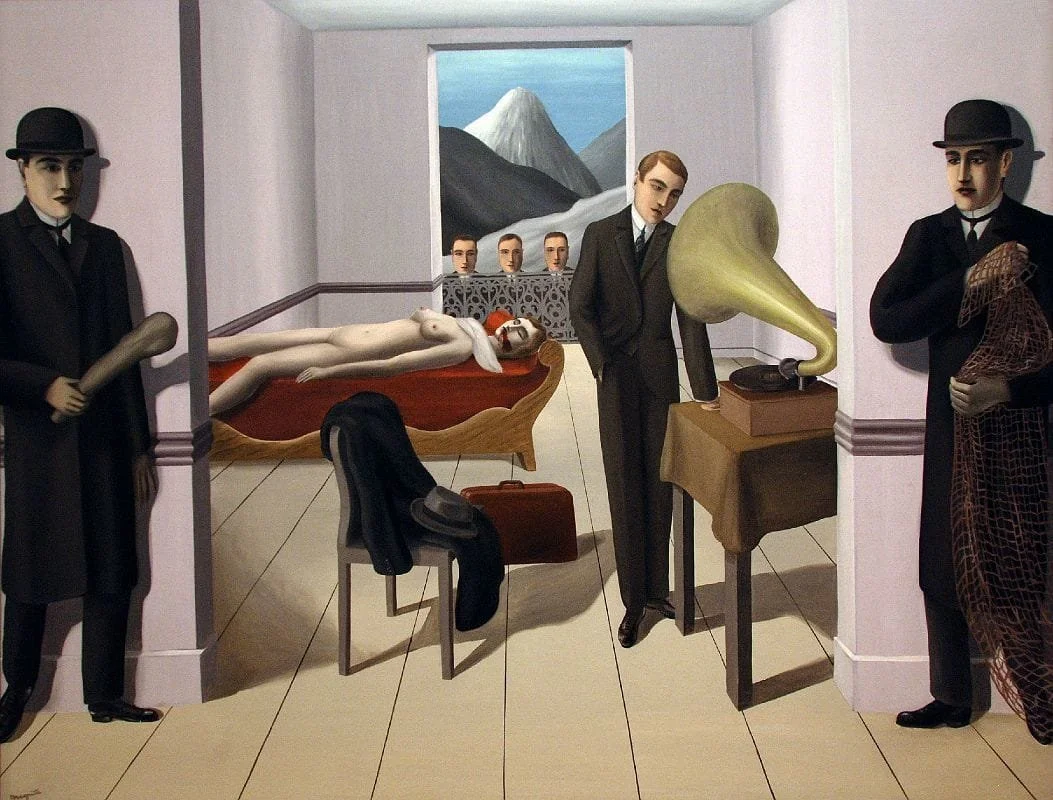Magritte’s The Menaced Assassin
Last week, in a moment of cultural parenting, I took my kid to MoMA. We wandered through the fifth floor, passing Van Goghs and Matisses. And then, like a scene out of a suspense thriller, we stumbled upon René Magritte's The Menaced Assassin. It's the kind of painting that stops you in your tracks—not because it’s particularly beautiful, but because it’s profoundly unsettling.
René Magritte, that Belgian superstar of the Surrealist movement, had a knack for taking the everyday and twisting it just enough to make you feel like you’ve stepped into a parallel universe. The Menaced Assassin, painted in 1927, is a prime example of this trickery. It’s a masterpiece of mystery and tension, the kind of painting that practically dares you to figure it out.
Imagine this: a stark room, lit with that unforgiving overhead lighting that makes everything look a little too real. A woman lies dead on a table, blood coming out of her mouth, her body disturbingly pale against the darkened surroundings. It’s as clinical as a crime scene, as if the room itself is complicit in the act. Nearby, a man—let’s call him our assassin, since Magritte doesn’t bother with subtlety—stands coolly listening to a gramophone, his back to the body. It’s this calm, this eerie nonchalance, that makes you shiver. He’s not panicking, not fleeing. He’s standing there, as if contemplating what record to play next.
But wait—there’s more. As if the scene isn’t tense enough, Magritte gives us an ensemble cast. Three men stand outside a window looking in. Their expressions? Who knows? Magritte didn’t give them faces worth noting. They’re just there, waiting, watching, and they’re clearly up to no good. Two more men lurk outside the room, their faces hidden in the shadows, heightening the sense of entrapment. Are they friends? Foes? Figments of our collective imagination? Who can say? Certainly not Magritte.
What’s brilliant—and deeply frustrating—about The Menaced Assassin is its complete refusal to explain itself. The narrative is both there and not there. Who is this woman? What led to her demise? And who, for the love of God, are these men? They’re like a chorus of voyeurs, anonymous and ominous, their presence raising more questions than answers.
This ambiguity is classic Magritte, a nod to the Surrealist goal of shaking up our perceptions of reality. Where someone like Salvador Dalí might melt clocks and warp landscapes, Magritte prefers to take something ordinary—like a man in a suit—and drop him into a situation so bizarre, it makes your skin crawl. Here, a well-dressed man, a gramophone, and a nondescript room are all you get. But when Magritte is done with them, they’re not just objects; they’re symbols—of what, exactly, is up to you.
And that’s the point, isn’t it? Magritte’s paintings are less about what they show and more about how they make you feel. The Menaced Assassin is often described as cinematic, and it’s true—this could be a still from some long-lost film noir, caught in a moment of high tension. You’re not just a viewer; you’re a participant, uncomfortably aware that you’re watching something you maybe shouldn’t be.
What’s worse, you’re drawn in by the perspective. The room is slightly elevated, as if you’re looking down on the scene from a hidden vantage point, maybe through the eyes of another unseen character. This voyeuristic twist only adds to the discomfort, making you question your role in this macabre scenario. You’re not innocent.
Magritte’s use of symbolism is the kind of thing that makes art historians salivate. The men in bowler hats—Magritte’s favorite stand-ins for the faceless everyman—could be symbols of societal pressure, or maybe the inevitability of justice. The gramophone? A bizarrely calm accessory to the violence, like an afterthought in the midst of chaos. It’s a piece of leisure in a scene of horror, an object so out of place that it becomes sinister by association.
At its core, The Menaced Assassin is about detachment, alienation, and the unsettling realization that the world is a lot more complicated—and a lot more terrifying—than we’d like to think. Magritte shows us a man who can commit an atrocity and then calmly listen to music, a juxtaposition that forces us to confront the dissonance between appearance and reality, action and consequence.
So, what did my kid think of all this? She asked if the man was in trouble. “Big time,” I said, and we moved on to the next gallery, where things made a lot less sense—but in a much less terrifying way.
